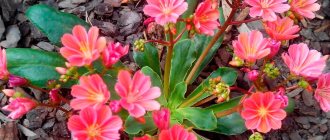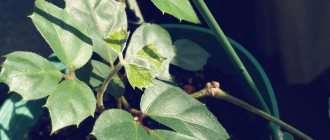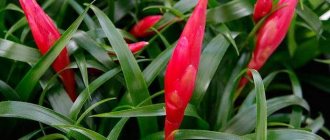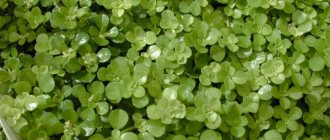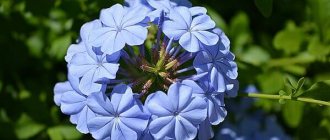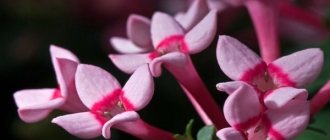Description of the plant
Codiaum is a perennial evergreen shrub with an erect, highly branched stem. Under natural conditions and with proper care, the height of the plant can reach 3-4 m .
The leaves are large, leathery, and arranged alternately. The shape of the plate can be varied: oval, lanceolate, guitar-shaped, with a pointed or rounded tip. The edges can be wavy, curled, or even. The color of the leaves is bright. Yellow, red, green, chocolate and orange shades stand out. Young plants are lighter, but over time the color becomes richer and darker.
Codiaum blooms with small light yellow flowers that are of no decorative value.
Harm and benefit to humans
Croton is a very beautiful decorative flower that is perfect for decorating apartments and office spaces. But even the most beautiful flower has positive and negative properties.
Beneficial features:
- Croton gives faith in one's own strength. This property will be useful for those who need creativity.
- Croton makes a person more decisive and independent. This will help modest and shy people in life.
- No inspiration and no new ideas come to mind? Croton will help you get out of a creative crisis.
- Thanks to croton, depression will go away irrevocably, and the person will tune in to a positive perception of the world.
- Croton will increase the level of eloquence.
The most harmful property of the flower for humans is that it has poisonous juice, which can cause unpleasant consequences for the body. But there are a number of warnings regarding the positive properties of croton, which can change polarity and become negative.
So who should refuse this beautiful flower in their home?
- People predisposed to hysterical behavior. Croton enhances energy, which means it will be more difficult to find peace.
- Noisy and talkative people. There will definitely not be silence in the same room with a croton.
- Not recommended for workaholics. Since croton helps increase energy and activity, you can simply forget that the body needs rest.
- Not recommended for impulsive people. Croton will only enhance this feeling, and spontaneity can often play a cruel joke.
Varieties of codiaum
Currently, more than 10 species of this indoor plant are known. The following varieties are bred at home:
- Codium variegated or varigatum nervia. The height of the plant in natural conditions reaches 2−6 m. At home, the plant is a medium-sized shrub with variegated, brightly colored leaves. On the surface of the leaf there are veins of red, green and orange.
- Peter's codiaeum. This is a shrub with highly branched shoots, which are covered with dense large leaves arranged alternately. The leaves are colored in a contrasting olive color. Along the edge of the sheet there is a yellow border.
- Codeium Excellent. The leaves have a lobed shape. The surface of the leaf blade is green with yellow veins on the outside and brownish-red on the inside.
- Codiaum Mammi. The variety is distinguished by small wavy leaves curved along the central vein. The leaf color combines red, green, and pink.
- Codeum Sunny Star. The predominant color of the leaves is yellow, the tip of the leaf and the edge may have a light olive tint. The leaves of young plants are beige in color, which over time changes to bright red and later to sunny yellow with small pink specks.
- Codium Mix. The leaves are large, linear in shape, reaching a length of 20−30 cm. The color of the leaves depends on the variety.
- Codiaum Tamara. The leaves are lobed, elongated, spiral tips, light green in color with cream veins. There may be scarlet or yellow inclusions on the surface.
- Mrs. Eyeston's Codiaeum. The variety has short, wide leaves, colored yellow. The leaf color of young plants is creamy, changing to bright red or pink with age. In some subspecies, the leaf blades may be black.
- Codiaum aucubifolia. The leaves are narrow, greenish-yellow in color. This variety is widespread in indoor floriculture.
Codiaeum or Croton - care and reproduction.
The genus Codiaeum includes 17 species of plants, which in natural conditions in Australia, India, Malaysia, the Sunda and Moluccas Islands reach a height of 3 meters. The genus belongs to the Euphorbiaceae .
At home, in order to grow Codiaum up to 1.5 meters, you will have to make a lot of effort, so it rarely exceeds 70-120 cm. The name of the genus Codiaum comes from the Greek word κώδεια (kodeia), which means “head”. It is often called Croton, but what croton means is unknown.
You can read about creating a florarium and a garden in a bottle with your own hands using Codiaum in a separate article: We create a garden in a bottle and a florarium with our own hands.
Of the 17 species of Codiaeum, only variegated (Codiaeum variegatum) and its varieties are used for growing at home.
Home care
When caring for codiaum excelent at home, you should remember that this plant is poisonous, so you should be careful.
Under natural conditions, codiaum grows in the tropics, so it needs constant bright but diffuse lighting. The flower does not tolerate direct sunlight, which can cause burns on the leaves. Pots with flowers are usually placed on east or west windows. On the north side, the shrub does not have enough light, so it stretches out and loses the decorative color of its leaves. In this case, the plant needs additional lighting with phytolamps.
Codium is thermophilic, so for normal development the flower should be provided with a constant temperature of at least +24 ° C in the summer and +19 ° C in the winter. In winter, pots can be placed next to heating appliances. This will help avoid temperature changes.
The shrub will not tolerate drafts and cool air, so it does not need to be ventilated and placed on a balcony or veranda.
When caring for codiaum variegum at home, ensure constant and abundant watering. However, moisture stagnation should not be allowed, which can cause root rot and plant death. For irrigation use warm, settled water. You can avoid stagnation of moisture if you plant the flower in a tight pot. This measure will promote rapid growth of the root system. The next watering should be carried out when the top soil layer dries slightly.
To maintain high humidity, the plant is sprayed daily. Once a month you can take a warm shower. You should also periodically wipe the leaves with a damp sponge to remove dust.
To feed codiaum, ready-made complex fertilizers are used. Fertilizers are applied once every 7-10 days in summer and once every 40 days in winter.
To ensure proper crown formation, shoots are periodically pruned. The first pinching is needed when the height of the young plant reaches 15-20 cm. Pruning is carried out using a sharp knife. All sections should be treated with crushed activated carbon. Also, during pruning, excess shoots that thicken the crown and dried leaves are removed. The procedure is carried out regardless of the time of year.
About caring for Codiaum or Croton:
Temperature: The optimal temperature for Codiaum in summer is 25-27 ºC, and in winter the temperature should not fall below 18 ºC. There should not be a strong difference in temperature between night and day. Codiaum is a heat-loving plant, but it is not recommended to place it near radiators or heaters in winter. In summer, the plant may suffer from the cold air flows of the air conditioner, so it should not be placed under air conditioners or in critical proximity to them. The plant is afraid of drafts and hypothermia of the root system. In the summer, you can take it out onto the balcony or terrace, but you must protect it from direct sunlight, wind and precipitation.
Lighting: The codiaum needs bright diffused lighting without direct sunlight, and windows facing western and eastern directions are well suited for it.
Watering: Should be frequent and plentiful. It is necessary to water with warm, soft, settled water. The frequency of watering depends on the temperature of the content. In summer, the plant has active growth and an increased need for water, and watering must be carried out regularly in order to prevent the substrate from drying out. In winter, watering is reduced, but you should not let the soil dry out completely. The soil should not be too waterlogged, as this can lead to rotting of the roots. The water from the pan must be drained after watering.
Air humidity: Codiaum is very demanding on air humidity and its daily procedure should be to spray the leaves with soft, settled water in the morning and evening, like a mist, especially if the plant is kept in a room with dry air. Regular spraying will preserve the decorative appearance and improve the well-being of the plant. In order to increase humidity, you can use pallets with wet expanded clay. In this case, the bottom of the pot should not touch the water. It is useful to spread moist sphagnum moss on the soil surface. It is necessary to clean the leaves from dust and periodically give the plant a shower, but make sure that after the shower the drops do not remain on the foliage.
Crown formation: The plant responds well to shaping, which must be done by pinching to give the desired shape. Young plants must be pinched annually, removing buds from the upper shoots, which will help to obtain a lush crown.
Fertilizers : It is necessary to fertilize Codiaum in spring and summer 2 times a month. For feeding, complex fertilizers for decorative deciduous plants are used.
Soil: Suitable for decorative deciduous plants, universal substrate. Be sure to add charcoal, coconut soil and pine bark to the soil. A good, wide layer of drainage at the bottom of the pot is necessary.
Transplantation: A young copy of Codiaum is replanted once a year, preferably in the spring, in order to accelerate the development of the plant, and adults only once every 2-3 years by transshipment, shaking off excess soil. Without replanting, it can stretch and shed its leaves. The pot should be deep and 1-2 cm larger than the previous one. Codiaum develops better in a cramped pot. After transplantation, the plant is not fertilized for a month. If replanting is not carried out, it is recommended to replace the top layer by adding fresh substrate.
Transplantation and soil
The plant should be replanted for the first time 1-14 days after purchase. The flower is carefully pulled out of the pot and cleaned of any remaining soil. The new pot should be slightly larger than the previous one. A layer of expanded clay is placed on the bottom and a layer of nutritious soil is poured.
Annual replanting is required for young plants; adult shrubs are replanted once every 2 years.
For the proper development of a flower, a loose nutrient substrate is required that allows moisture and air to pass through well. For planting, you can use ready-made soil mixture. The soil, prepared independently, should consist of equal parts of leaf and turf soil, humus, peat and medium-grained sand. The soil mixture should be calcined in the oven or disinfected before use. After planting, the bush should be watered abundantly.
Appearance and origin
Croton Excellent, like all its fellows from Southeast Asia, in nature grows to the size of an average tree. Its height ranges from 2.5 to 4 m. It develops this way thanks to the warm and humid climate of the tropical forests. New varieties of codiaum, bred as domestic varieties as a result of selection, cannot boast of such a height, however, they retain their requirements for heat, moisture and light when caring for them.
The Excelent variety stands out for its spectacular appearance. It is decorated with bizarrely shaped leaves reminiscent of oak leaves. The color of the crown is strikingly multicolored: different shades can coexist quite well on the same plant.
Features of reproduction
Codiaum is propagated by cuttings, regardless of the time of year. To do this, the top of an adult shrub is cut off to a length of 10 cm. The milky sap is removed from the cut site and treated with charcoal or sulfur, then the shoot is placed in a solution of a growth stimulator and planted in a mixture of sand and peat. The plant is placed in a warm room, periodically watered and sprayed. After the first roots appear, the flower is planted in a permanent place. With proper care, rooting occurs within three weeks.
Codium can be propagated by leaves. To do this, a large leaf is cut from the mother plant, the milky juice is removed and placed in a nutrient mixture. Cover the top of the container with a glass jar or plastic bag. The soil is moistened as the surface dries. After several stems have developed on the plant, it is transplanted to a permanent place.
Propagation by seeds is not practiced in indoor floriculture. The seeds have low germination capacity, and young plants do not retain the characteristics of the species.
Croton is poisonous, precautions
If you decide to have croton at home, you should remember that it is poisonous. Its juice may leave a burn on the skin, cause vomiting or stomach upset, but this is not the worst thing. If, through negligence, the juice enters the bloodstream through an open wound, it can be fatal.
A number of precautions must be taken when handling this dangerous beauty:
- All work with the flower should be carried out wearing protective gloves.
- After caring for the plant, regardless of the actions performed, wash your hands thoroughly with soap.
- Keep children away from the plant.
- Keep in places inaccessible to pets.
Diseases and pests
Codiaeum is demanding in terms of maintenance conditions, therefore, if the rules of care are not followed, the plant may be susceptible to insect pests:
- scale insects;
- mealybug;
- spider mite;
- nematodes.
Diseased plants should be treated with a solution of laundry soap and rinsed thoroughly with running water. Insecticidal agents can be used for treatment.
Codiaum is an evergreen tropical plant with unusually beautiful leaves. Some lovers of indoor plants consider it capricious, but with proper care it will become a real decoration of the interior.
Health and Harmony
Health benefits are not the most well-known feature of croton. However, it may be useful for treating diseases:
- kidney;
- adrenal glands;
- Bladder.
Croton is imbued with warming energy, which will help protect against diseases caused by hypothermia. You shouldn’t put all the responsibility for recovery on croton, but it will work great as an additional energy boost in addition to treatment.
We suggest you familiarize yourself with what it is called when a demon possesses a person
As for harmony in the home, you should not have unrealistic expectations: croton rather brings chaos to order than calms and allows you to accept things as they are. This is an ideal houseplant for those who want to change their life, rather than resign themselves to it.
Harmony from croton is harmony through order, established routine, life and work. At first you will have to try to achieve it, but then life will be not only effective, but also satisfying.
Persons who value a certain chaos in business, relationships and things should not have a croton.
Signs and superstitions about croton
Croton was also not spared by signs and superstitions. There is an opinion that this flower will perfectly take root in the home of creative individuals, because it is able to give inspiration and set people up to achieve new goals and create new creations.
It is also good to have it for those who often conflict with people around them, as this plant has a calming effect. If the owner of the flower is indecisive and constantly rushes between several options for solving a problem, then croton helps to become more decisive and self-confident. The plant helps to avoid rash actions and mistakes, as it rewards the owner with wisdom and foresight.
It is also useful to place this plant in offices of office buildings. It helps avoid work conflicts and improves work mood. Croton also helps develop eloquence. This is especially useful for people who cannot express themselves clearly.
General information
The codiaum flower feels good when grown indoors. This plant has many varieties , each of which has its own leaf color. Codiaum Mix looks especially beautiful on the windowsill. The shades of the leaves of different varieties are different; the leaf blades of crops can be yellow, dark purple and even red . Pink spots are clearly visible on individual leaves.
It is quite difficult to obtain inflorescences from a crop when caring for it at home. If all growing conditions are met, codiaum blooms in the warm season, in summer.

